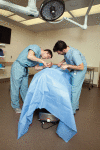Stretching and Strength Training to Improve Postural Ergonomics and Endurance in the Operating Room
- PMID: 33133890
- PMCID: PMC7572150
- DOI: 10.1097/GOX.0000000000002810
Stretching and Strength Training to Improve Postural Ergonomics and Endurance in the Operating Room
Abstract
Plastic surgeons report the highest prevalence of chronic musculoskeletal pain and fatigue among surgical subspecialties. Musculoskeletal pain impacts daily life, career longevity, and economic burden secondary to occupational injury. Poor postural awareness and ergonomic set up in the operating room represent the most common etiology.
Methods: A literature review was performed to highlight the ergonomic set-up, postural pitfalls, occupational injuries, and musculoskeletal pain in the operating room. An institutional survey was administered among resident and attending surgeons regarding musculoskeletal pain, posture, ergonomic education, and future improvements. Literature results, survey data, and intraoperative photographs were analyzed in collaboration with physical therapists and personal trainers.
Results: Survey results demonstrated that 97% of resident and attending respondents experienced musculoskeletal pain and 83% reported a lack of education in posture and ergonomics. The main postural pitfalls included head forward and flexed positioning, abduction and internal arm rotation, and kyphosis of the thoracic spine. The collaborators developed instructional videos to assess posture and biomechanics and demonstrate targeted stretching and strength exercises to address specific neck, back, and shoulder pain.
Conclusions: Poor posture is unavoidable in the operating room at times. These educational videos should be utilized for self-motivated and prophylactic conditioning outside of the operating room to maintain physical well-being throughout a career in plastic surgery. Future focus should be aimed at implementing dedicated ergonomic education and physical wellness programs early in surgical resident training.
Copyright © 2020 The Authors. Published by Wolters Kluwer Health, Inc. on behalf of The American Society of Plastic Surgeons.
Conflict of interest statement
Disclosure: The authors have no financial interest to declare in relation to the content of this article.
Figures










Similar articles
-
Individualized ergonomic wellness approach for the practicing gastroenterologist (with video).Gastrointest Endosc. 2021 Aug;94(2):248-259.e2. doi: 10.1016/j.gie.2021.01.045. Epub 2021 Feb 6. Gastrointest Endosc. 2021. PMID: 33561486
-
Objective assessment of postural ergonomics in neurosurgery: integrating wearable technology in the operating room.J Neurosurg Spine. 2024 Apr 19;41(1):135-145. doi: 10.3171/2024.1.SPINE231001. Print 2024 Jul 1. J Neurosurg Spine. 2024. PMID: 38626470
-
Ergonomic hazards in otolaryngology.Laryngoscope. 2019 Feb;129(2):370-376. doi: 10.1002/lary.27496. Epub 2018 Nov 25. Laryngoscope. 2019. PMID: 30474217
-
Surgeon Strength: Ergonomics and Strength Training in Cardiothoracic Surgery.Semin Thorac Cardiovasc Surg. 2022 Winter;34(4):1220-1229. doi: 10.1053/j.semtcvs.2021.09.015. Epub 2021 Sep 29. Semin Thorac Cardiovasc Surg. 2022. PMID: 34597795 Review.
-
Ergonomic Considerations in Urologic Surgery.Curr Urol Rep. 2023 Mar;24(3):143-155. doi: 10.1007/s11934-022-01142-5. Epub 2022 Dec 29. Curr Urol Rep. 2023. PMID: 36580226 Review.
Cited by
-
Importance of Exercise for Career Longevity: Maintaining Fitness, Strength, and Flexibility as a Plastic Surgeon.Plast Reconstr Surg Glob Open. 2025 Jan 29;13(1):e6439. doi: 10.1097/GOX.0000000000006439. eCollection 2025 Jan. Plast Reconstr Surg Glob Open. 2025. PMID: 39882430 Free PMC article.
-
Enhancing Surgical Robotic Skills Through Performance-Guided Training: A Swimmer's Approach for Defining Key Metrics.JSLS. 2025 Apr-Jun;29(2):e2024.00066. doi: 10.4293/JSLS.2024.00066. Epub 2025 Apr 23. JSLS. 2025. PMID: 40291479 Free PMC article.
-
The Sculptor: An Ergonomic Tool for Enhanced Precision in High-definition Liposculpture.Plast Reconstr Surg Glob Open. 2025 Aug 13;13(8):e7061. doi: 10.1097/GOX.0000000000007061. eCollection 2025 Aug. Plast Reconstr Surg Glob Open. 2025. PMID: 40809373 Free PMC article.
-
Female Surgical Ergonomics in Otolaryngology.Oper Tech Otolayngol Head Neck Surg. 2025 Jun;36(2):132-138. doi: 10.1016/j.otot.2025.05.008. Epub 2025 May 14. Oper Tech Otolayngol Head Neck Surg. 2025. PMID: 40861043
-
Surgical fatigue syndrome and EDiS3 intervention, should every surgeon need to know how to mitigate muscle skeletal discomfort?Surg Open Sci. 2023 Nov 2;16:184-191. doi: 10.1016/j.sopen.2023.10.014. eCollection 2023 Dec. Surg Open Sci. 2023. PMID: 38035222 Free PMC article.
References
-
- Waehrer G, Leigh JP, Miller TR.Costs of occupational injury and illness within the health services sector. Int J Health Serv. 2005;35:343–359. - PubMed
-
- Davis WT, Fletcher SA, Guillamondegui OD.Musculoskeletal occupational injury among surgeons: effects for patients, providers, and institutions. J Surg Res. 2014;189:207–212.e6. - PubMed
-
- Rosenblatt PL, McKinney J, Adams SR.Ergonomics in the operating room: protecting the surgeon. J Minim Invasive Gynecol. 2013;20:744. - PubMed
-
- Soueid A, Oudit D, Thiagarajah S, et al. The pain of surgery: pain experienced by surgeons while operating. Int J Surg. 2010;8:118–120. - PubMed
LinkOut - more resources
Full Text Sources
Medical
